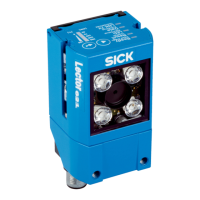371 Transmision Type
The processing and triggering procedures for process data objects (PDOs) are config‐
ured via the Transmision Type parameter. The CANopen parameter defines the process‐
ing and triggering time in relation to the SYNC object. The SYNC object is used to syn‐
chronize the CAN nodes on the CAN bus and, together with the TIME STAMP object,
ensures that the time is standardized across the network. The parameter must be
entered in accordance with the CANopen standard.
0xFE example: The device processes and transmits PDOs as soon as new data
becomes available.
There are three different transfer types:
•
ASYNCHRONOUS: The PDOs do not have any kind of relationship with the SYNC object.
PDOs are processed as soon as they have been received and sent immediately
after they have been triggered. The trigger can be controlled by an event or a send
request.
•
SYNCHRONOUS: PDOs are processed with temporal reference to the SYNC object. It is
possible to set the number of SYNC objects required before processing takes
place.
•
ACYCLIC SYNCHRONOUS: PDOs are received without any reference to the SYNC object
but are not processed until after the next SYNC object. The PDO is triggered by an
event without any reference to the SYNC object but is not transmitted until after
the next SYNC object.
372 Trigger echo on
If the Start by parameter is set to the COMMAND signal source and the Trigger echo on
parameter is activated, the sensor responds by sending the command back to the con‐
trol.
This allows the control to check SOPAS commands that have been sent.
373 Trigger Distribution
The Trigger Distribution group is used to define how the trigger signal is communicated
to network nodes.
In the case of a network with several reading devices, it is often sufficient to use a pho‐
toelectric switch or connect a reading device to the control. The trigger signal is then
distributed to the network nodes.
The Trigger Distribution function can be used to reduce the trigger signals and the num‐
ber of photoelectric switches considerably. This leads to a significant reduction in sys‐
tem complexity and cost.
374 Trigger delay
The Trigger delay parameter allows you to choose between a configuration based on
length units and a configuration based on time units.
•
DISTANCE-CONTROLLED: The values for the Pause, Reading gate length, Start delay,
and Stop delay parameters are entered in mm. If a distance-controlled delay is set,
the reading gate only opens once the object has continued traveling for a prede‐
fined distance after the trigger signal is issued.
•
TIME-CONTROLLED: The values for the Pause, Reading gate length, Start delay, and
Stop delay parameters are entered in ms. If a time-controlled delay is set, the
reading gate only opens once a predefined time has elapsed after the trigger sig‐
nal is issued.
SOPAS PARAMETER OVERVIEW
122
O N L I N E H E L P | Lector62x 8013778/YPV6/2016-01-14 | SICK
Subject to change without notice

